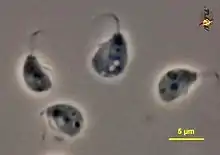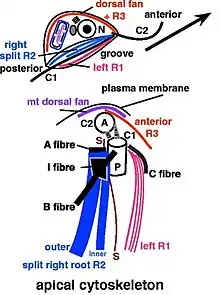Malawimonas
Malawimonas is a Loukozoa genus, possible sister of the Podiata.[2][3]
| Malawimonas | |
|---|---|
 | |
| Scientific classification | |
| Domain: | Eukaryota |
| Phylum: | Loukozoa |
| Class: | Malawimonadea |
| Order: | Malawimonadida |
| Family: | Malawimonadidae |
| Genus: | Malawimonas O’Kelly & Nerad 1999 |
| Species[1] | |
| |
History of the discovery of Malawimonads
In 1993, Charles J O’ Kelly studied the jakobid groups flagellates and implications for the early diversification of eukaryotes and recognized that Jakoba, Reclimonas, and Histonia or often refer as “core jakobids” were morphologically somewhat similar. Interestingly, they included an unnamed and undescribed free-swimming, flagellate, and also groove- bearing cell.[4][5]
During the early study, these cells were thought to be a member from Jakoba due to the external morphology features that resembles Jakoba libera in terms of lack of cell covering, sessile trophic stages, swimming in a similar manner and sharing the tendency for the anterior flagellum to form a “crook. However, later discovery found that this species seems to not fit and can not be assigned to the genus Jakoba, nor to any other genus of Jakobids, because of their discoidal mitochondrial cristae, which is different from Jakoba that have irregularly flattened, and the other Jakobids member have tubular mitochondrial cristae.[6]
This undescribed organism was later described formally as Malawimonas jakobiformis and placed in its own new family Malawimonadidae, a bacterivorous heterotrophic isolated from the Malawi shore of Lake Nyasa (eastern Africa).[6]
Only more than a decade later, a related organism has been studied under several studies that revolved around the phylogenetic positions of the Jakobids and Cercozoans group under the names Malawimonas californiana, but there are no formal descriptions included.[7][8][9]
Characterization

Malawimonas share some common features with the jakobids and other Excavata group members by having a conspicuous feeding grove on the ventral side and two flagellates. The overall cytoskeleton of Malawimonas resembles Carpediemonas, typical Excavata belonging to the anaerobic Metamonada clade and closely related to Diplomonads and Retormonads.[3][9]
Malawimonas jakobiformis characterized by a uninucleate, biflagellate, heterotrophic, “naked” cell, where neither scales nor lorica was present. Observation of the ultrastructure revealed a substantial glycocalyx as a surface coat. The cells of Malawimonas are usually slender, and the shape is plastic and often deformed by influences such as coverslip pressure or food they digest. The two flagella are approximately 1- 1.5 times as long as the cell body and are more or less equal length. The anterior flagellum has a “crook” shape where the posterior flagellum is appresed but not attached to the ventral cell surface. Cells swim in straight lines a and turn longitudinal axes as they move. The posterior flagellar vane of Malawimonas jakobiformis arises from a clearly defined point on the ventral surface of the flagellum. In contrast, the other jakobids’ vane has a diffuse origin along the dorsal surface.[6][10]
Malawimonas, Jakobids, and Mitochondrial Origin
The early study of molecular investigations revealed that the genome of Reclinomonas americana, Jakoba libera and Malawimonas jakobiformis collectively represent the most eubacterial-like mitochondrial DNAs yet discovered among all eukaryotes.[7] Jakobids group have all the basic forms of mitochondrial cristae known in eukaryotes. The mitochondrial shape has been seen as a strongly conserved character and is used to delimit the deepest evolutionary division within eukaryotes.[11]
Malawimonas position within Eukaryotes
A study based on alpha and beta- tubulin phylogenies found that Malawimonas jakobiformis occupied a relatively basal position in the plant-protists superclade and showed the distinctness from the “core jakobids”.[11]
References
- "Malawimonas". BioLib.
- Cavalier-Smith T (November 2003). "The excavate protozoan phyla Metamonada Grassé emend. (Anaeromonadea, Parabasalia, Carpediemonas, Eopharyngia) and Loukozoa emend. (Jakobea, Malawimonas): their evolutionary affinities and new higher taxa". Int. J. Syst. Evol. Microbiol. 53 (Pt 6): 1741–58. doi:10.1099/ijs.0.02548-0. PMID 14657102.
- Simpson AG (November 2003). "Cytoskeletal organization, phylogenetic affinities and systematics in the contentious taxon Excavata (Eukaryota)". Int. J. Syst. Evol. Microbiol. 53 (Pt 6): 1759–77. doi:10.1099/ijs.0.02578-0. PMID 14657103.
- O'KELLY, CHARLES J. (September 1993). "The Jakobid Flagellates: Structural Features of Jakoba, Reclinomonas and Histiona and Implications for the Early Diversification of Eukaryotes". The Journal of Eukaryotic Microbiology. 40 (5): 627–636. doi:10.1111/j.1550-7408.1993.tb06120.x. ISSN 1066-5234. S2CID 85938682.
- Simpson, A. G. B. (2003-11-01). "Cytoskeletal organization, phylogenetic affinities and systematics in the contentious taxon Excavata (Eukaryota)". International Journal of Systematic and Evolutionary Microbiology. 53 (6): 1759–1777. doi:10.1099/ijs.0.02578-0. ISSN 1466-5026. PMID 14657103.
- O'KELLY, CHARLES J.; NERAD, THOMAS A. (September 1999). "Malawimonas jakobiformis n. gen., n. sp. (Malawimonadidae n. fam.): A Jakoba-like Heterotrophic Nanoflagellate with Discoidal Mitochondrial Cristae". The Journal of Eukaryotic Microbiology. 46 (5): 522–531. doi:10.1111/j.1550-7408.1999.tb06070.x. ISSN 1066-5234. S2CID 84289745.
- Gray, Michael W.; Lang, B. Franz; Burger, Gertraud (2004-12-01). "Mitochondria of Protists". Annual Review of Genetics. 38 (1): 477–524. doi:10.1146/annurev.genet.37.110801.142526. ISSN 0066-4197. PMID 15568984.
- Rodríguez-Ezpeleta, Naiara; Brinkmann, Henner; Burger, Gertraud; Roger, Andrew J.; Gray, Michael W.; Philippe, Hervé; Lang, B. Franz (August 2007). "Toward Resolving the Eukaryotic Tree: The Phylogenetic Positions of Jakobids and Cercozoans". Current Biology. 17 (16): 1420–1425. doi:10.1016/j.cub.2007.07.036. ISSN 0960-9822. PMID 17689961. S2CID 15014715.
- Archibald, John M.; Simpson, Alastair G.B.; Slamovits, Claudio H., eds. (2017). Handbook of the Protists. Cham: Springer International Publishing. doi:10.1007/978-3-319-28149-0. ISBN 978-3-319-28147-6. S2CID 43539893.
- O'Kelly, Charles J. (December 1997). "Ultrastructure of trophozoites, zoospores and cysts of Reclinomonas americana Flavin & Nerad, 1993 (Protista incertae sedis: Histionidae)". European Journal of Protistology. 33 (4): 337–348. doi:10.1016/s0932-4739(97)80045-4. ISSN 0932-4739.
- Edgcomb, Virginia P.; Roger, Andrew J.; Simpson, Alastair G. B.; Kysela, David T.; Sogin, Mitchell L. (2001-04-01). "Evolutionary Relationships Among "Jakobid" Flagellates as Indicated by Alpha- and Beta-Tubulin Phylogenies". Molecular Biology and Evolution. 18 (4): 514–522. doi:10.1093/oxfordjournals.molbev.a003830. ISSN 1537-1719.